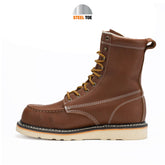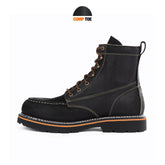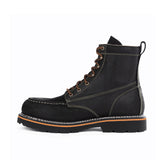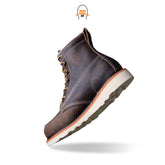Why an 8-inch boot?
Let’s start here, do you live in a home in a developed neighborhood? Picture what all THAT looked like two years before your development was built. Forest. Now picture what it took to develop that land. The trees had to come down, the lot had to be leveled, a road paved, holes dug, gravel, water retention areas dug, underground utilities planted, foundations poured, heavy equipment, back hoes, dozers. On top of that, before any of this happened, someone had to walk that land, make decisions and then start developing. An 8-inch boot provides ankle support to walk through this stuff. To stand in it, maneuver through it, and most importantly, work 10-14 hours a day in it. It’s not pretty. Picture that land looking like a bulldozer rolled through it, because it did, and now you’re working in that brush. Your ankles get twisted very easily, and you can lose your footing very quickly. The higher boot provides support, some leg protection against brush, even bug bites. Mosquitos always aim for the ankles, and they always get you. Now they can’t. Have you ever seen what falls into a boot in these conditions? Twigs, leaves, dirt, sand. A higher boot prevents that. Nothing worse than sweating all day with a piece of tree bark scrapping against your foot inside a boot. You can take the boot off and clear the stuff, but where are you going to do that? No chairs. No place to put your foot down, it’s mostly mud. You could balance yourself on one leg for a minute maybe, not fun though. It’s a special type of work environment, and people that actually wear these 8-inch boots know. Many don’t.
Now, let’s talk about water and the elements that come with working outdoors. Most people do not truly understand the complete and total punishment of what the outdoors can bring, because they’re viewing it from a window. It’s a quick glance or an afterthought. But not for people working 12 hours a day in it. The worst thing you can have is wet feet in the cold. People in construction stand in the dirt, in mud, in water. They can’t let that water spill into the actual boot. It’s over from there. There’s no drying it out at that point. What do you do when it happens at 10 in the morning? You still have six hours to go! You’re freezing! There’s no warming up. It’s brutal. The boots you wear are what keeps you going. They need to protect you. Try doing that in a 6-inch boot. It’s going to be tough; you need the extra height.
Then there’s this, trip hazards are real. Pant legs are a very real tripping hazard. This mostly depends on where, and how high you potentially can fall. Are you on staging? Are you on a metal beam fifty feet up? Are you on a ladder 30 feet up the side of a house? Are you flashing a chimney on a job no one else wanted to take on, because it was too high up? If you kick your pant leg in those situations? Plain and simple, you are probably going to die. So, what do you do? You can’t tuck a pant leg in a 6-inch boot, but you can in an 8-inch boot. When you’re back on level ground you can easily pull them out. You could also tape them. I’ve seen guys bungee cord their pant legs. It hurts though. Circulation does mean something. You can wear leg pads too, as long as they can stay secure. But bottom line, you need to tuck them into a boot too, and the 8-inch gives you that little bit of extra space to do it.
Of course, some people just have “bad ankles”. Ever hear someone say that? I have bad ankles. Sore ankles, easily twisted ankles, easily rolled ankles. I swear to God this is 100% a real thing. A person that will just flat out roll an ankle while walking on gravel (or even flat cement), when no one else will. Just enough to put them out of work for two weeks. These people are going to want an 8-inch boot. Sometimes they don’t even need the other benefits of the boot, they just need the ankle support.
I also want to briefly talk further about things that can land on your leg and fall into your boot in some industries. Slag. Welders melt metal, it’s slag, it’s liquified metal and it’s 1,500 degrees Celsius. It hurts. It’ll burn a hole right into your skin and scar you for life. This stuff is falling all day on welders, they need the extra protection an 8-inch boot can provide. The last thing they need is a piece of molten metal falling inside their boot, if the laces go up high it covers more surface area.
Diesel techs. These guys tend to go with a higher boot. Diesel techs are dealing with bigger stuff. Bigger than an auto tech. These guys need leg protection when something drops. They’re standing so close to engine heads, springs, blocks, whatever, and when that thing falls? It’s not just hitting their foot; it’s hitting their lower leg and ankle. A nice slab of leather adds protection. These guys are also lifting heavy stuff, they need the added support. An 8-inch boot can feel like an extension of a tool. A leverage device. A strengthening device. These guys swear by the higher boots, they say they’re comfortable too.
Blousing your boots. This is what you see in the military. Tying the pant leg down to the top two eyelets of the boot area, using a blousing strap or tucking them into the inside of the boot. There’s a couple of reasons for this; one, when you’re thrashing through forest or jungle, you’ll want to keep your pant legs from dragging in the mud, and two, it’s a way to prevent bugs and critters from crawling up your pant leg or into your boot. A higher boot is great for this because it gives you leather protection higher up your calf.
Something else to consider with an 8-inch boot. Not all 6-inch boots are created equal, some are higher than others, some are lower. And some just don’t land where you’d like them to on your ankle. The Duradero 6-inch boot comes up a little taller than most 6-inch boots I’ve owned, and I like that. Some 6-inch boots will land directly on your ankle area, when you’re working all day and flexing the ankle area, it doesn’t always feel good. An 8-inch boot eliminates this problem - there are a lot of people that will want the freedom and flexibility of a shorter boot - but with an 8-inch boot, once it’s broken in, you always have the option of loosening the laces, and providing yourself with some flexibility, while also having that extra support.
The eight inch boot is a choice for some, but for others it’s a necessity.







